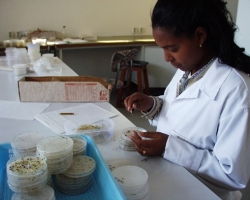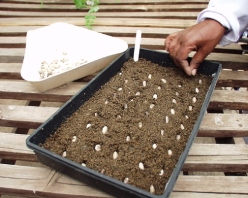Viability testing of germplasm
.jpg) View section on seed viability testing by clicking on the icon above (0.7 MB) |
Page compiled by: Bioversity International/ILRI, Addis Ababa, Ethiopia (Alexandra Jorge); ILRI, Addis Ababa, Ethiopia (Jean Hanson) including information extracted from: Rao NK, Hanson J, Dulloo ME, Ghosh K, Nowel D and Larinde M. 2006. Manual of seed handling in genebanks. Handbooks for Genebanks No. 8. Bioversity International, Rome, Italy. 147pp.
What is viability testing
Seed or plant viability is the measure of how many seeds or how much plant material in a lot are alive and could develop into plants that will reproduce under appropriate field conditions.
Why should viability be determined
|
Testing seed viability (photo: ILRI) |
It is very important that seeds or plant material stored in the genebank are capable of producing plants when sown in the field. They must have high viability at the start of storage and maintain it during storage. Seeds or plant material with a high initial viability will also survive longer in storage. Seed or plant viability declines slowly at first and then rapidly as the seeds or plant material age. It is important to know when this decline occurs in order to take action to regenerate the accession. Excessive deterioration will lead to loss of material.
When should viability be determined
Seed material
- Before seeds are packaged and placed in the genebank.
- At regular intervals during storage.
Viability testing is crucial for the monitoring of seed conservation. It can take from a few days to weeks, depending on the species. If possible, the results of viability tests should be made available before seeds or plant material are packaged and placed in the genebank so that poor quality seeds can be identified and regenerated.
While awaiting the results of viability tests, or if there is a delay in conducting the viability tests before storage, seeds should be placed in a cool environment to minimize their deterioration.
Tissue culture plant material
- Viability tests should be carried out after long periods of storage.
- When abnormalities are seen.
Cryo plant material
- Short term after induction.
How should viability be determined
The determination of viability depends on the species and method of conservation.
Seed material
- Many different methods are available to test seed viability.
- The most accurate and reliable method is the germination test.
- There are also biochemical tests, which have the advantage of being quicker, but are not as accurate as the germination test. They also require special skills to conduct and interpret. These tests are not usually recommended for general use to test for seed viability in genebanks.
Plant material (tissue culture and cryopreservation)
- The viability test is used to test whether the material can be rejuvenated into a whole plant that can grow under natural conditions.
The germination test (applicable for seeds)
|
Testing germination in sand (photo: ILRI)
Testing germination on filter paper (in tray)(photo: ILRI) |
What is a germination test
A germination test is performed to determine what proportion of seeds in an accession will germinate under favourable conditions and produce seedlings judged as normal according to specific criteria for each species [see Association of Seed Analysts (AOSA), 2005; ISTA, 2005]. This is because the aim of seed testing is to give an indication of how the seeds will perform as propagules in the field.
When are seedling defects classified as abnormal?
How is germination tested
Basic requirements for seed germination are: water, oxygen, light and suitable temperature. Seeds of different species have different requirements and no general set of conditions can be relied upon to germinate seeds of all species. Seeds of some species are more tolerant and germinate in a wide range of conditions but complete germination can only be achieved under optimum conditions. Seed dormancy is seen when seeds imbibe water under suitable temperature and light for germination but germination does not occur.
- Before germination, seeds need to be humidified and often pre-treatments need to be used to break dormancy:
- A variety of methods are recommended for each species:
- But sometimes there are species without much information and new methods need to be developed:
- Backup procedures can also be used to identify viable but dormant seeds that fail to germinate at the end of germination tests:
-
The most common methods are detailed in the links below and illustrated in the flip books.
-
Top of paper germination method: Flipbook, Text (print version).
- Between paper germination method: Flipbook, Text (print version).
- Germination in sand method: Flipbook, Text (print version).
-
Agar germination method: Flipbook, Text (print version).
-
Top of paper germination method: Flipbook, Text (print version).
How many seeds should be tested
- A fixed sample size germination test using 200 seeds in 4 replicates of 50 seeds is recommended as best practice to determine viability at the beginning of storage.
- Four replicates of 100 seeds is recomended in the ISTA rules. However, best practices take into account the limited number of seeds available and the aim of not wasting seeds in unnecessary testing.
- Overall seed viability should be taken as the mean of the replicates.
References and further reading
AOSA (Association of Official Seed Analysts) 2005. Page 113 in: Rules for Testing Seeds (Capashew Ed.), 4-0, 4-11. Las Cruces, NM.
FAO. 2013. Genebank standards for plant genetic resources for food and agriculture. Food and Agriculture Organization of the United Nations, Rome. Available in English, Spanish, French, Arabic, Russian and Chinese here.
ISTA. 2008. International Rules for Seed Testing. International Seed Testing Association. ISTA secretariat, CH-Switzerland. Available from: www.seedtest.org/.
Rao NK, Hanson J, Dulloo ME, Ghosh K, Nowel D, Larinde M. 2006. Manual of seed handling in genebanks. Handbooks for Genebanks No. 8. Bioversity International, Rome, Italy. Available in English (1.5 MB), Spanish (1.4 MB) and French (1.9 MB).
Thormann I, Metz T, Engels JMM. 2004. The Species Compendium (release 1.0; December 2004). [online] Available from: http://www.bioversityinternational.org/databases/species_compendium_database/index.html. Date accessed 09 April 2013.
Comments
- No comments found







.jpg)
Leave your comments
Post comment as a guest